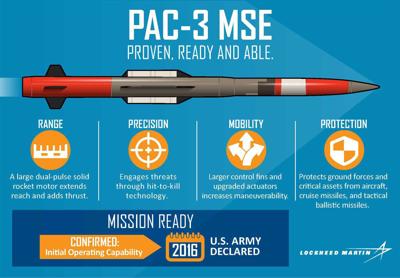WHITE SANDS MISSILE RANGE, NM -- For the first time, Lockheed Martin’s Patriot Advanced Capability – 3 (PAC-3) successfully integrated with the Lower Tier Air and Missile Defense Sensor (LTAMDS) radar to defend against an Air Breathing Threat (ABT).
The LTAMDS radar is a key component to advance the U.S. Army’s modernized air and missile defense strategy.
During the flight test at White Sands Missile Range, PAC-3 sent and received data from the LTAMDS radar to engage the ABT. This mission demonstrates PAC-3 can maintain its proven Hit-to-Kill intercept performance while integrating with the LTAMDS radar.
Final assembly of the PAC-3 is performed in Camden.
“Today’s test is another example of how Lockheed Martin is advancing modernized air and missile defense capabilities for 21st Century Security,” said Brenda Davidson, vice president of PAC-3 Programs at Lockheed Martin Missiles and Fire Control. “Integrating with LTAMDS is a crucial step towards fielding a modernized IAMD solution for the U.S. Army to keep our Soldiers ahead of evolving threats.”
To prepare for the flight test, Lockheed Martin worked in partnership with the U.S. Army to conduct a series of ground testing and captive carry tests. This builds upon previously demonstrated PAC-3 capability with the U.S. Army’s Integrated Battle Command System (IBCS).
PAC-3 uses Hit-to-Kill technology to defend against threats through direct body-to-body contact that delivers exponentially more kinetic energy on the target than can be achieved with blast-fragmentation mechanisms. PAC-3 is effective against current and evolving threats including aircraft, tactical ballistic missiles and cruise missiles.



























